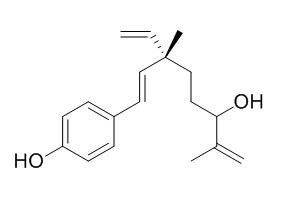12-Hydroxyisobakuchiol
Standard reference
Inquire / Order:
manager@chemfaces.com
Technical Inquiries:
service@chemfaces.com
Tel:
+86-27-84237783
Fax:
+86-27-84254680
Address:
1 Building, No. 83, CheCheng Rd., Wuhan Economic and Technological Development Zone, Wuhan, Hubei 430056, PRC
Providing storage is as stated on the product vial and the vial is kept tightly sealed, the product can be stored for up to
24 months(2-8C).
Wherever possible, you should prepare and use solutions on the same day. However, if you need to make up stock solutions in advance, we recommend that you store the solution as aliquots in tightly sealed vials at -20C. Generally, these will be useable for up to two weeks. Before use, and prior to opening the vial we recommend that you allow your product to equilibrate to room temperature for at least 1 hour.
Need more advice on solubility, usage and handling? Please email to: service@chemfaces.com
The packaging of the product may have turned upside down during transportation, resulting in the natural compounds adhering to the neck or cap of the vial. take the vial out of its packaging and gently shake to let the compounds fall to the bottom of the vial. for liquid products, centrifuge at 200-500 RPM to gather the liquid at the bottom of the vial. try to avoid loss or contamination during handling.
The Japan Society for Analy. Chem.2017, 66(8):613-617
Food Funct.2021, 12(4):1469-1481.
Evid Based Complement Alternat Med.2021, 8707280.
Cell Biochem Funct.2018, 36(6):303-311
Wageningen University & Research2018, January 2018
J Agric Food Chem.2021, 69(46):14037-14047.
Antioxidants (Basel).2020, 9(4):284.
Biol Pharm Bull.2018, 41(1):65-72
Int J Mol Sci.2023, 24(17):13230.
Evid Based Complement Alternat Med.2018, 2018:4259603
Related and Featured Products
Nat Prod Res. 2015;29(6):586-8.
Antiphytopathogenic activity of Psoralea glandulosa (Fabaceae) against Botrytis cinerea and Phytophthora cinnamomi.[Pubmed:
25184663]
METHODS AND RESULTS:
The resinous exudate, three meroterpenes, namely bakuchiol (1), 3-hydroxybakuchiol (2), 12-Hydroxyisobakuchiol (3), and one furanocoumarin, psoralen (4), were isolated from the leaves of culen (Psoralea glandulosa). In addition to these, two semi-synthetic derivatives, bakuchiol acetate (5) and bakuchiol methyl eter (6), were obtained from 1, and were subsequently evaluated in vitro for the inhibitory effect of resin and compounds on the mycelial growth of Botrytis cinerea Pers.: Fr. and Phytophthora cinnamomi Rands. The resinous exudate inhibited the mycelial growth of both the pathogens, while bakuchiol (1) exhibited an inhibitory effect on the mycelial growth of B. cinerea up to 94% at a concentration of 150 mg/L and psoralen (4) reduced the mycelial growth of P. cinnamomi up to 80% at a concentration of 150 mg/L.
CONCLUSIONS:
These compounds have the ability of blocking the development of mycelial growth and may be used as a potential biopesticide in the agricultural sector once the in vivo test results have been validated.
Chinese Pharmaceutical Journal, 2003 , 55 (1) :77-81.
Meroterpenes and C-glucosylflavonoids from the aerial parts of Plumbago zeylanica[Reference:
WebLink]
METHODS AND RESULTS:
Two meroterpenes bakuchiol and 12-Hydroxyisobakuchiol, and three C-glucosylflavonoids, saponaretin, isoorientin and isoaffinetin together with other constituents plumbagin, isoshinanolone, xanthyletin, xanthoxyletin, psoralen, plumbagic acid, plumbagic acid butyl ester, β-sitosterol and β-sitosteryl glucoside have been isolated from the aerial part of Plumbago zeylanica.
CONCLUSIONS:
This is the first report of isolation of meroterpenes and C-glucosylflavonoids from Plumbago species.



